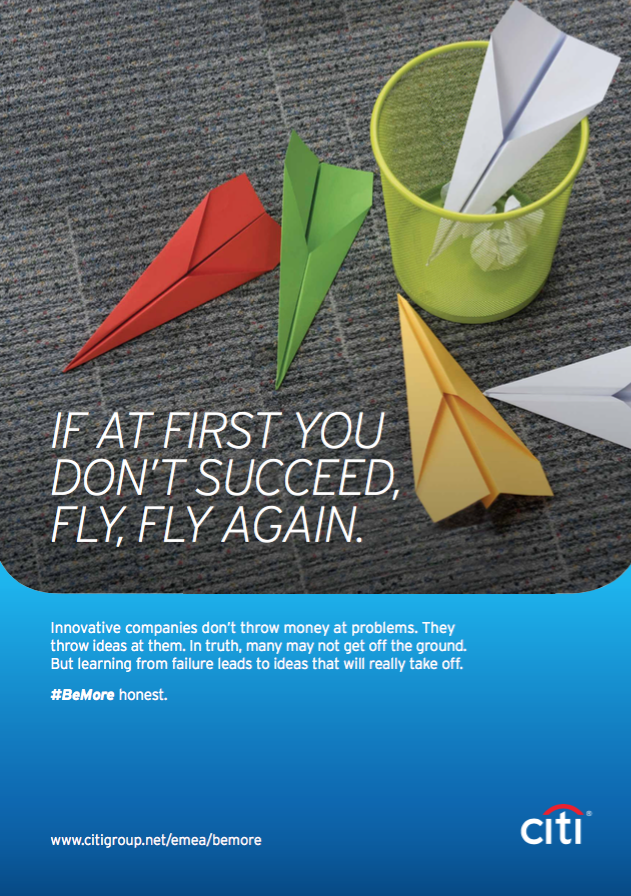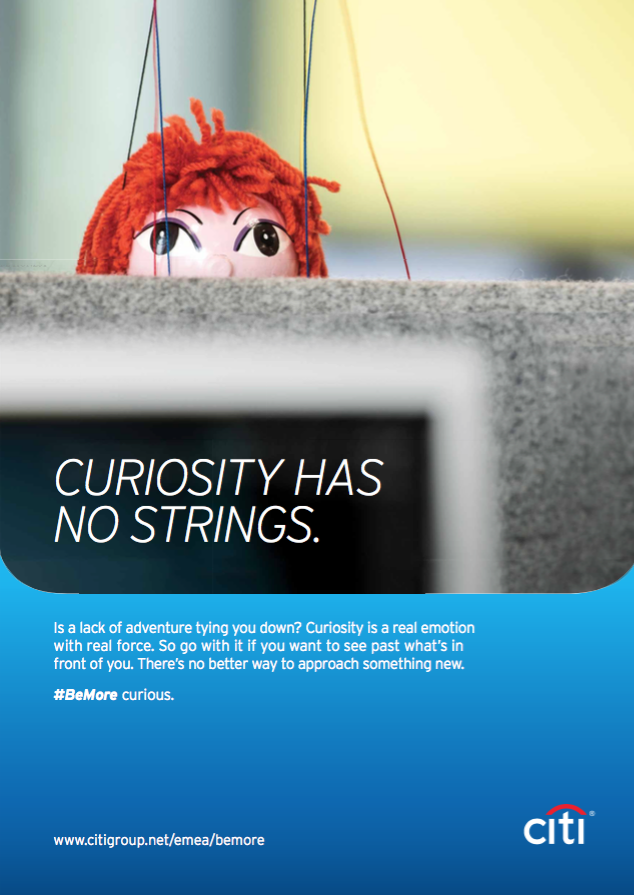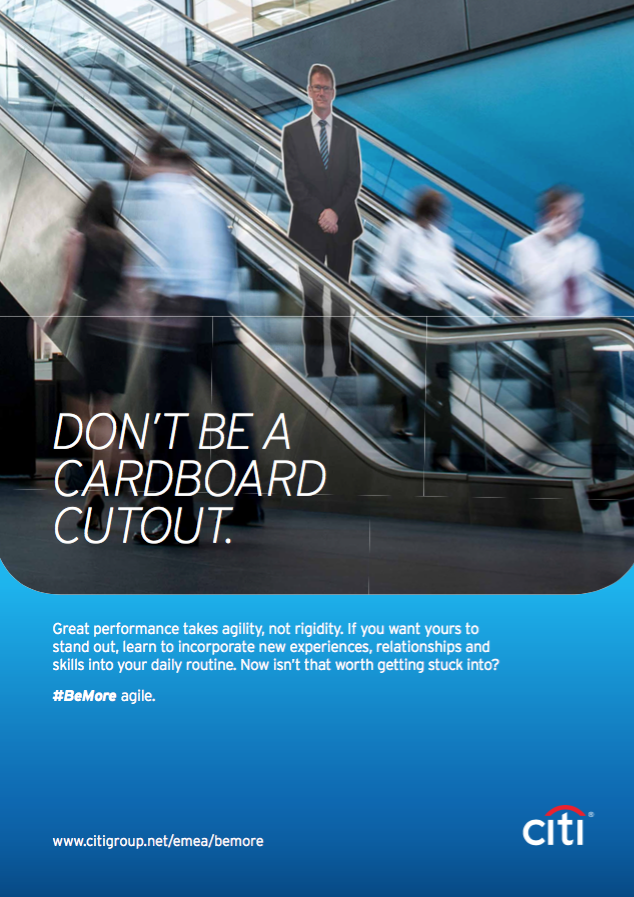Welcome to the second column in the “Learning Agility” series. For those just tuning in, check out the introductory column here; it explores working definitions, diagrams, and more. Otherwise, let’s dive into our first case study: Citi’s adventures in continuous learning.
Learning agility at Citi
“Leaders are positioning learning as a key enabler for business success and serving our clients. We’re talking a common language; there’s less reliance on formal training, more questioning, and better coaching. Rigor of extracting learning from failure and other practices are becoming mainstream.”
That’s how Brian Murphy, head of learning and leadership at Citi, EMEA (Europe, Middle East, and Africa), described the impact of Citi’s award-winning learning campaign and their ongoing work around continuous learning.
Participants’ engagement scores—double the average—and an increase in individual development plans and learning activities back up Murphy’s words. Other positive data has been drawn from regular learning surveys and idea jams.
So, what’s the impact on performance? In truth, it’s difficult to tell.
Citi’s recent strong growth is a matter of record, although the causal factors behind any such growth are so complex that isolating them becomes a matter of opinion rather than fact. At the very least, we can say that the parallel between Citi’s growing learning culture and its strong results is encouraging.
What did the campaign look like?
On one level, it looked like a slick, clever marketing campaign.
Citi adopted the “3E” framework—experience, exposure, and education—to help popularize and develop an understanding of 70:20:10 principles. They packaged this under the #BeMore banner, as part of a non-HR branded campaign.
You can see a glimpse of the outputs in this video and in the motivational poster on failure in Figure 1, the poster on curiosity in Figure 2, and the poster on agility in Figure 3.

Figure 1: Citi motivational poster on failure. Reproduced with permission from Citi.

Figure 2: Citi motivational poster on curiosity. Reproduced with permission from Citi.

Figure 3: Citi motivational poster on agility. Reproduced with permission from Citi.
Murphy highlighted two specific initiatives in the campaign:
“The first was the 30-day development challenge,” he said. “This saw five thousand of our people taking 30 micro-action challenges, one per day, for 30 days. These were opportunities to practice continuous learning and then reflect and share.”
The “micro actions” consisted of 10-minute activities, such as reflecting, talking to someone new, or even sharing a piece of useful advice.
“The second standout,” Murphy said, “were the manager cards. These ID-sized cards gave managers three questions to turn their one-to-one meetings into development conversations—supporting reflection and learning from experience.”
Learning leadership
The learning campaign had the sort of leadership engagement that most L&D professionals would kill for. Murphy explained how his team facilitated this: “We built the business case for building organizational readiness for what’s next and the need to continue to adapt to serve our clients successfully. It’s a very powerful value proposition, particularly with the degree of change happening and affecting our business model.”
This engagement continued throughout the campaign, with senior leaders recording video messages about their development stories using the 3E framework. Leaders were also given a hands-on experience of the 3E approach, with their own learning pathways.
Social learning
Consistent with the 3E messaging, Murphy and his team supported social learning to help engage staff. “We used ‘Collaborate,’ our in-house enterprise social and collaborative platform, to engage with a learning community around continuous learning,” Murphy said. “It was a great channel to introduce concepts and content, but also to encourage social learning and mobilize a community who are passionate about developing themselves and their colleagues. It’s become a movement within the company, an identity, and a brand in itself.”
New skills for L&D
The campaign challenged Citi’s L&D professionals to “walk the talk” and set an example by becoming everyday learners.
Specifically, Murphy pointed to conscious skills development around diverse areas, including facilitating learning communities, marketing, performance consulting, curation, behavioral science, analytics, and impact measurement.
Next steps
Of course, continuous learning never stops, so what does Citi have planned?
“Our main aim is to continue to link the work to the business strategy and narrative,” Murphy said. “We’re continuing to bring the 3E learning philosophy to more areas of the organization, such as talent development. We’re also focusing on moving further into the performance paradigm and thinking about continuous learning as a true driver for high performance of individuals, teams, and the entire organization.”
One of my main takeaways was Citi’s excellent use of marketing techniques to reframe and excite people about continuous learning. In addition, I was struck by their effective stakeholder engagement, involving leaders in every stage of the process. Perhaps most inspirational is the implicit view that the campaign is a work in progress that will continue to evolve and develop.
For Murphy, the main takeaway is simple. “Don’t develop continuous learning for the sake of it—do it to support the business strategy and drive business performance.”
For now, keep an eye on the Citi’s continuous learning journey by following Brian Murphy on twitter. And, I highly recommend that you download these insightful Citi case studies:
Next time
Please leave your thoughts and takeaways about the Citi experience below. And be sure to keep an eye out for the next Learning Agility column, which will feature leading L&D researchers Laura Overton from Towards Maturity, Aaron McEwan from Gartner, and Dani Johnson from RedThread Research talking about learning agility.
Until then, if you’ve got ideas or stories for this Learning Agility column, please contact me via LinkedIn or Twitter.



